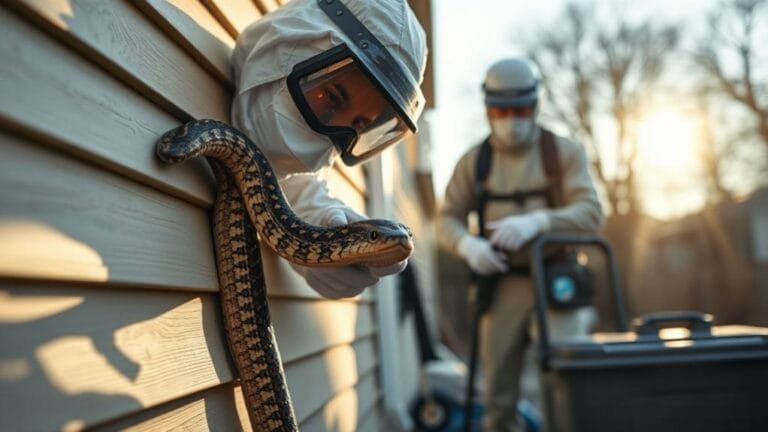Are you worried if Snake-A-Way is safe for your furry friend? This article has the answers you need.
Snake-A-Way contains sulfur and naphthalene, which can be harmful to dogs if ingested in large amounts. But don’t fret! We’ll guide you on how to protect your dog by using Snake-A-Way safely.
From reading the label to applying it in dog-free zones, we’ve got you covered. We’ll also explore natural alternatives and physical barriers to keep your pup safe.
Stay informed and keep your dog free from snake encounters.
Key Takeaways
Table of Contents
- Naphthalene, an ingredient in Snake-A-Way, can be toxic to dogs if ingested in large quantities.
- Pet owners may prefer natural snake repellents over chemical-based products for their dogs.
- Additional measures such as sealing cracks and removing hiding spots should be taken to minimize the risk of encountering snakes.
- Safety precautions should be followed when using Snake-A-Way around dogs, including keeping dogs away from treated areas and seeking immediate veterinary attention if ingestion occurs.
Understanding the Ingredients of Snake-A-Way
You should be aware that Snake-A-Way contains sulfur and naphthalene, which can be toxic to dogs if ingested in large quantities.
When considering the pros and cons of using chemical-based snake repellents for dogs, it’s important to compare the safety of Snake-A-Way to other similar products.
While Snake-A-Way may effectively repel snakes, the presence of sulfur and naphthalene raises concerns about potential toxicity for dogs.
It’s essential to prioritize the safety of our furry friends when choosing snake repellents.
Natural alternatives, such as cedar oil, cinnamon, clove oil, and garlic, may offer a safer option.
Additionally, physical barriers like fencing and sealant can help keep snakes away without the use of chemicals.
Consider these alternatives to ensure the well-being of your dog while still effectively deterring snakes.
Potential Risks for Dogs With Snake-A-Way
Using Snake-A-Way around your pets may pose risks, including ingestion, allergic reactions, chemical burns, and toxicity. It’s important to weigh the pros and cons of using chemical-based snake repellents for dogs.
Pros of using chemical-based snake repellents:
- They’re specifically designed to repel snakes.
- Some users have reported success in keeping snakes away from their properties.
- They can be effective when used in conjunction with other snake deterrent methods.
Cons of using chemical-based snake repellents:
- There’s a risk of ingestion, which can be toxic to dogs.
- Allergic reactions and chemical burns are possible.
- The effectiveness of Snake-A-Way may vary depending on the type of snake and the environment.
Comparing the effectiveness of Snake-A-Way versus natural snake repellents for dog safety, it’s worth considering alternatives such as cedar oil, cinnamon, clove oil, and garlic. Physical barriers like fencing and netting can also be effective.
Ultimately, choose the method that works best for your situation and keeps your dog safe.
Safety Precautions for Using Snake-A-Way Around Dogs
When applying Snake-A-Way, be sure to read the label carefully and follow the safety precautions to minimize any potential risks for your furry friend. It’s important to prioritize the safety of your dog when using any snake repellent.
While Snake-A-Way is designed to repel snakes, it contains naphthalene which can be toxic to dogs if ingested in large quantities.
To ensure your dog’s well-being, use the product in areas inaccessible to dogs or keep them indoors until it has settled.
If your dog accidentally ingests Snake-A-Way, seek immediate veterinary attention.
Symptoms of naphthalene poisoning in dogs include vomiting, diarrhea, lethargy, and difficulty breathing.
Consider using natural alternatives like cedar oil, cinnamon, clove oil, or garlic as dog-friendly snake repellents.
Additionally, physical barriers such as fencing, netting, and sealant can help minimize snake encounters for dogs.
Choose the method that best suits your needs while prioritizing your dog’s safety.
Alternatives to Snake-A-Way for Dogs
Consider natural repellents like cedar oil, cinnamon, clove oil, or garlic as safer alternatives for protecting your dog from snakes. These natural snake repellents can be effective in deterring snakes and keeping your furry friend safe.
Additionally, physical barriers such as fencing, netting, and sealant can help keep snakes away from your property. By creating a barrier, you can prevent snakes from entering your dog’s play area or living space.
It’s important to choose the method that works best for your situation and keeps your dog safe. Natural repellents and physical barriers provide a non-toxic and reliable approach to snake prevention, ensuring your dog’s freedom and well-being.
Effectiveness and Usage of Snake-A-Way
You should be aware that the effectiveness of Snake-A-Way in repelling snakes may vary depending on the type of snake and the environment. While Snake-A-Way is designed to repel snakes, its effectiveness isn’t guaranteed.
Some users have reported success in keeping snakes away from their properties with this product. However, it’s important to note that the type of snake and the specific environment can influence the effectiveness of Snake-A-Way. Results may vary, so it’s crucial to have realistic expectations when using this repellent.
Alternatively, natural repellents such as cedar oil, cinnamon, clove oil, and garlic can be used as alternatives. These natural options may have varying degrees of effectiveness, but they don’t contain chemicals that could harm the environment.
Reported Cases of Dogs and Snake-A-Way
If your dog shows signs of illness after coming into contact with Snake-A-Way, it’s important to seek veterinary care. While Snake-A-Way is designed to repel snakes, there have been reported cases of dogs experiencing gastrointestinal symptoms after ingesting the product.
To prevent such incidents, it’s crucial to take safety precautions when using Snake-A-Way around dogs. Read the label carefully before applying the product and use it in areas inaccessible to dogs or keep them indoors until it has settled.
If your dog ingests Snake-A-Way, seek immediate veterinary attention. Symptoms of naphthalene poisoning in dogs may include vomiting, diarrhea, lethargy, and difficulty breathing.
It’s also important to consider alternative snake repellents and physical barriers as preventive measures.
Proper Application of Snake-A-Way
Applying Snake-A-Way in a band around the designated area and lightly watering it after application helps activate the product. This method has been shown to enhance the effectiveness of Snake-A-Way as a snake repellent.
However, it’s important to note that Snake-A-Way isn’t the only solution for snake prevention. Proper sealing techniques should also be implemented to minimize the risk of encountering snakes. Sealing cracks and removing potential hiding spots can significantly reduce the chances of snakes entering your property.
Additionally, natural repellents such as cedar oil, cinnamon, clove oil, and garlic can be used as alternatives to Snake-A-Way. It’s crucial to choose the method that works best for your situation and keeps you and your dog safe.
Remember to have realistic expectations, as the effectiveness of Snake-A-Way may vary depending on the type of snake and the environment.
Conclusion and Recommendations for Dog Owners
As a dog owner, it’s important to prioritize the safety and well-being of your furry friend when it comes to snake encounters. Here are some key conclusions and recommendations to consider:
Utilize dog-friendly snake repellents:
- Opt for natural alternatives such as cedar oil, cinnamon, clove oil, or garlic.
- These repellents can help deter snakes without posing a risk to your dog’s health.
Be vigilant for signs of snake encounters in dogs:
- Keep an eye out for symptoms like sudden pain, swelling, or puncture wounds.
- Watch for behavioral changes such as anxiety, excessive barking, or avoidance of certain areas.
Seek immediate veterinary attention if needed:
- If you suspect your dog has been bitten or ingested snake repellent, don’t delay seeking professional help.
- Prompt medical intervention can prevent complications and ensure your dog receives appropriate care.
Frequently Asked Questions
Can Snake-A-Way Be Safely Used Around Cats and Other Pets?
Snake-A-Way can be safely used around cats and other pets, but precautions should be taken. Keep pets away from treated areas until the product has settled. If any signs of illness occur, seek veterinary care immediately.
Are There Any Long-Term Health Effects for Dogs Exposed to Snake-A-Way Over Time?
Long term use of Snake-A-Way around dogs may pose health risks. Though evidence on specific long-term effects is limited, potential risks include ingestion, allergies, burns, and toxicity. Seek veterinary attention if needed.
What Should I Do if My Dog Comes Into Contact With Snake-A-Way and Exhibits No Symptoms of Illness?
If your dog comes into contact with Snake-A-Way and shows no signs of illness, it’s important to monitor them closely. Keep them away from the treated area and observe for any changes in behavior or health.
Are There Any Natural Alternatives to Snake-A-Way That Are Safe for Dogs?
There are natural alternatives to Snake-A-Way that are safe for dogs. Cedar oil, cinnamon, clove oil, and garlic can be used. The effectiveness of Snake-A-Way varies, so it’s important to have realistic expectations.
Can Snake-A-Way Be Used Indoors to Repel Snakes?
Snake-A-Way can be used indoors as an indoor snake repellent. Its effectiveness indoors may vary depending on the type of snake and the environment. However, it’s important to consider other snake deterrent methods for optimal results.
Conclusion
In conclusion, when it comes to the safety of your furry friend, it’s crucial to approach the use of Snake-A-Way with caution.
While the ingredients in this popular snake repellent can be toxic to dogs, taking proper safety precautions such as reading the label, applying the product in inaccessible areas, and seeking immediate veterinary attention if ingestion occurs can help minimize the risks.
Considering alternative methods such as natural repellents and physical barriers may also be worth exploring to ensure your dog’s safety.
Stay informed and make decisions that prioritize your beloved canine companion’s well-being.








